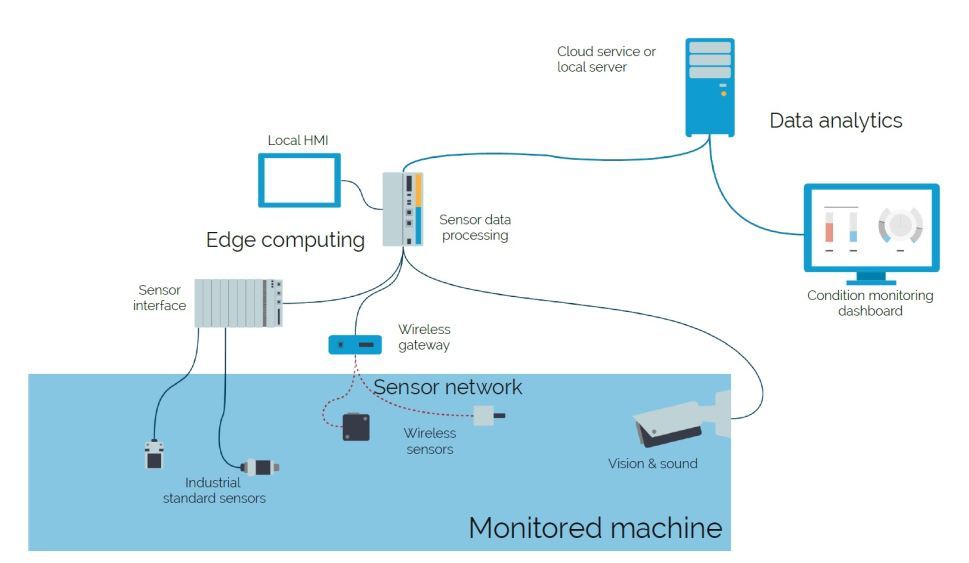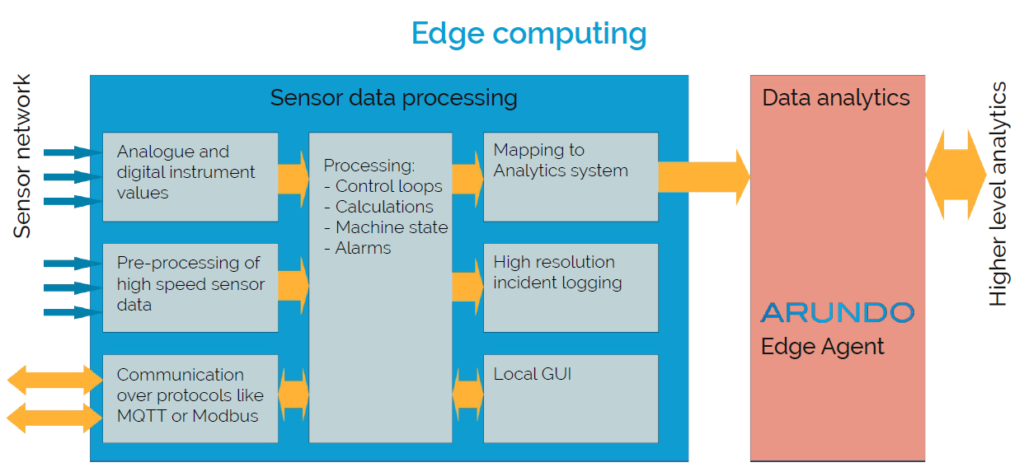
Summary
By using a condition monitoring analytics service, the data acquisition and pre-processing may use standard industrial components, this would be an alternative to the high-end bundled HW/SW condition monitoring systems. Your local supplier/integrator will be able to install and maintain the local system consisting of the sensor network, remote i/o and the industrial computers running the pre-processing. The local installation is thus completely stand-alone. For the analytics part, the system is a cloud service in most cases, but there are server based systems available as well. The result is a “value for money” condition monitoring system.
CDP Studio provides some benefits:
- No hardware vendor lock-in
- Open interface to Analytics provider
- Standard industrial sensors
- New sensing options like video and sound
- Wireless sensors reduce installation cost
This blog is also available as a downloadable pdf article.
The Challenge
Condition monitoring of machinery has been around for some time now, we have probably never had this much data available. The challenge is to bring this data flow to a system that can trend, learn, correlate, and predict. Applying proper condition monitoring to existing plants and machinery has been challenging:
- Adding instrumentation with new sensors has been relatively expensive, mostly due to installation cost
- The existing local control system should not be touched
- Some of the sensors generate a lot of data
- Predictive systems with sufficient storage has been extremely expensive
There are several providers of cloud based (or local) advanced predictive systems, the analytics part is now available as a service with a sensible price tag.

Implementation cost vs performance
The key to a “value for money” condition monitoring system is to limit the local hardware cost, i.e. sensors and data acquisition. In practical terms this implies increased use of wireless sensors and to stay away from specialist sensors with dedicated, bundled hardware. You still need hardware to bring your monitoring data to the analytics provider, but this is now viable to implement on standard industrial computers.
Building a condition monitoring system with standard industrial components may have some reduced performance compared to the dedicated, bundled, high-end condition monitoring systems, BUT at a dramatically lower price tag. The ROI of even basic condition monitoring measured in reduction of unwanted production shutdowns and increased maintenance intervals is a financial no-brainer compared to fault detection only.
In the following example we describe how we can combine the flexibility of CDP Studio to provide monitoring data to an analytics service provider, in this case Arundo (https://www.arundo.com/), a provider of machine learning software for industrial users with specific expertise in edge computing applications. The Arundo Edge Agent may run on the same IPC as the CDP controller, so it is a nice combination. The principles discussed here are however applicable for most other analytics providers as well.
Edge computing
To bring the monitoring data to the analysing system, we need to pre-process the data, as data analytics systems can receive complex data, but not at a very high refresh rate. By bringing computing power closer to the sensor, we can take the high frequency analogue signal and process it with e.g. FFT to add frequency spectrum information to the RMS values. The data bandwidth towards the analytics system is still low, but the information value has increased by magnitudes.
Bringing processing power closer to the sensors also open for use of other high bandwidth sensors, including sound and vision, areas where we will see rapid development going forward. CDP Studio is a suitable development platform for edge computing systems (or “fog computing”), as the CDP framework is designed for control signal processing. Edge computing in the context of condition monitoring may be summarised in the following elements:
- Running on small controllers
- Handling multiple protocols
- Integration with special sensors
- Connecting “read-only” to the existing local control
- Logging raw sensor data (rolling)
- Adding an optional local display
- Processing of sensor data
- Implementing local control loops for alarming
- Input to the local control system
System example
Our focus is the edge processing part, but obviously the interfacing to both the sensors as well as the analytics service is vital for the overall system performance.
We use the Arundo analytics system in this example, as the “Arundo Edge Agent” is a software application suited to run together with the CDP based edge processing system on the same Linux industrial computer. The handover to the analytics service is then not even a physical interface, but directly between the two applications. The key is that the high frequency signals are now processed into datasets with a cycle of 1 Hz or less; now suitable for digesting by the analytics service.
Which sensors to use and how to interface them is down to the automation integrator company delivering the hardware and local solution. The freedom of industrial computers is now visible; the CDP application is an effective abstraction layer between the sensors and analytics, but also adding local functions as needed. This is where the competence of the local integrator company adds value. CDP Studio comes with a range of pre-integrated remote i/o, and implementing specific interfaces is straight forward.
As pre-processing also imply losing data resolution, one of the most important additional functions for the CDP application is to provide means for high resolution logging; a continuous log covering a predefined time window is running in the application i.e. memory, but is saved automatically in the case any predefined conditions kick in. This way, “crash-data” will be retrievable for detailed incident analysis.
You may also need a local display showing real-time state of the local system or any warnings. This is something the integrator can implement, tailored to the actual machine, as this would be just standard GUI configuration in the CDP Studio development tool.

The condition monitoring system should be separated from the operation control system, but may share data both ways. As the CDP controller has a library of automation functions built in, a typical scenario is to provide “virtual instruments” calculated from a combination of the condition monitoring sensors input.
In a similar way you may provide alarms based on the real-time monitoring data.
With edge pre-processing of the monitoring data, you also have a single interface to the analytics provider, i.e. your installation is very easy to adopt to different analytics providers.
See other downloadable whitepaper in our document download page.